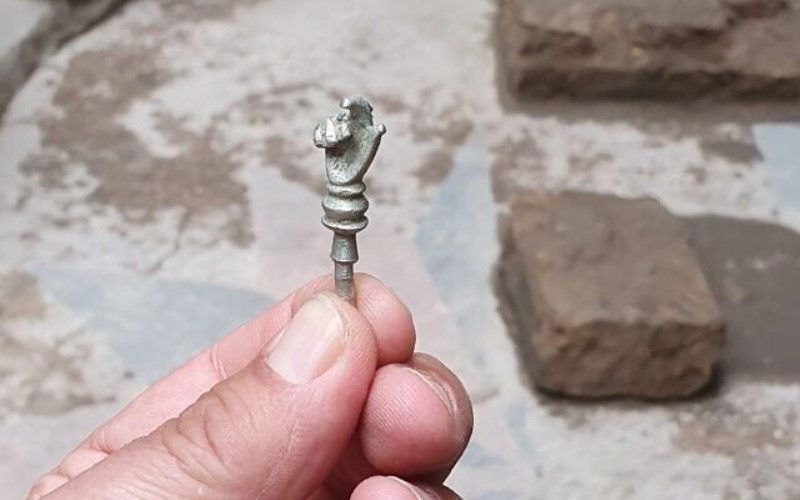Remains of Lithuanian Synagogue Destroyed by Nazis and Soviets Unearthed
Excavations uncovered the Great Synagogue of Vilna’s Torah ark, impressive staircases, a raised prayer platform and more
:focal(936x819:937x820)/https://tf-cmsv2-smithsonianmag-media.s3.amazonaws.com/filer/77/e9/77e983b1-ff4a-468f-b0c7-e499d3d5a0ec/torah_ark.jpeg)
Archaeologists in the Lithuanian capital of Vilnius have found sacred objects from the Great Synagogue of Vilna, which was partially destroyed by the Nazis before being razed by the Soviets in the 1950s, reports Michael Bachner for the Times of Israel.
Excavations led by a joint Israeli and Lithuanian team uncovered the Torah ark, or Aron Kodesh—the cabinet that holds a synagogue’s sacred scroll—and the bimah, or raised prayer platform. The dig also revealed a small, hand-shaped pointer known as a yad that was used during readings of the Torah. (The Torah ark was renovated in the 18th century after a large fire, the Jerusalem Post notes.)
Per a statement, the researchers have dedicated the past six years to discovering both the synagogue’s ruins and the remains of the Shulhoyf, a center of Torah and community study. As the Brussels Times reports, the team used ground-penetrating radar to locate the new finds.
Vilnius was once known as the “Jerusalem of Lithuania.” Built in the 17th century, the Great Synagogue was part of a large Jewish center that included schools, ritual baths, prayer halls and a community council. The building itself was constructed with its first floor well before street level in deference to a rule that synagogues couldn’t be built higher than churches. This allowed the structure to appear only three stories tall when, in fact, its inside “soared to over five stories,” notes the Vilna Great Synagogue and Shulhoyf Research Project on its website. Prominent figures connected to the synagogue included Rabbi Eliyahu ben Shlomo Zalman, an 18th-century scholar who wrote influential interpretations of Jewish scriptures.

Though Poland had seized control of Vilnius during the interwar period, it ceded the city and surrounding area back to Lithuania in October 1939, shortly after the Soviet occupation of eastern Poland began. Per the United States Holocaust Museum, the city was then home to about 55,000 Jews, who represented more than a quarter of the total population.
Germany’s occupation of Vilnius began on June 24, 1941. Nazi forces pushed the city’s Jews into two ghettos and began mass killing operations shortly thereafter. By the end of the year, the Germans had massacred about 40,000 Jews at a killing site established in Ponary forest, outside Vilnius.
The Soviet Union liberated the city in 1944. After the war ended, Soviet authorities leveled the partially destroyed synagogue and built a school atop its ruins. Per the Times of Israel, the Soviets razed all that remained of the grand house of worship between 1956 and 1957.
“When we arrived to excavate the Aron Kodesh and the Bimah, from which generations of Jews read the Torah scroll for 300 consecutive years, it became clear, unfortunately, that the core of the synagogue had been greatly damaged by Soviet destruction,” say archaeologists Jon Seligman of the Israel Antiquities Authority (IAA) and Justinas Rakas of the Lithuanian Cultural Heritage Preservation Forces in the statement.
Still, they add, the dig uncovered two impressive staircases visible in images taken of the synagogue prior to its destruction. The team also found the entire façade of the bimah, as well as the remains of one of four pillars that held up the building’s roof.
In the statement, Eli Eskozido, director of the IAA, says, “The recent discovery of magnificent parts of the Great Synagogue shows the potential for further excavation of the site, in anticipation of the exciting possibility of displaying the remains of the future.”
/https://tf-cmsv2-smithsonianmag-media.s3.amazonaws.com/accounts/headshot/Livia_lg_thumbnail.png)
/https://tf-cmsv2-smithsonianmag-media.s3.amazonaws.com/accounts/headshot/Livia_lg_thumbnail.png)